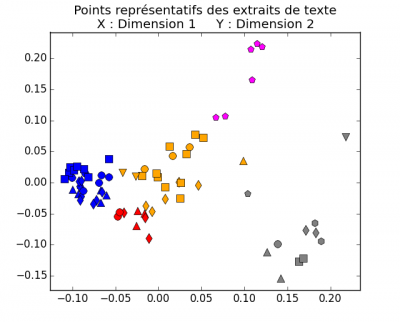This article by Claude-Alain Roten, OrphAnalytics, was published in the Swiss Magazine l'1dex, October 31 2017.
All statistical analyzes unambiguously reveal who writes for Elena Ferrante: Domenico Starnone
Nobody could meet the author of the best-selling novels signed Elena Ferrante. These books generate a strong interest, as shown by the success of English translations. In October 2016, rumors circulated that Elena Ferrante would receive the Nobel Prize for Literature before Bob Dylan got it.
Various writers have been proposed as author of these books with Neapolitan accents: from Domenico Starnone to Erri de Luca, through Michele Prisco. Other authors have been suggested as Goffredo Fofi or women: the historian Marcella Marmo or Anita Raja, Neapolitan by birth who grew up in Rome and who is the wife of Starnone. Some have even considered an unknown person, without writing experience, even a collective, which would explain the energy with which anonymity is preserved.
According to the journalist Paolo di Stefano of the Corriere della Sera, the candidacy of Domenico Starnone for the writing of the novels of Elena Ferrante is a recurring theme. This proposal, first suggested by Luigi Galella, was tested in 2006 by physics professor Vittorio Loreto and Andrea Baronchelli. These two researchers from La Sapienza University in Rome used software developed by fellow mathematicians that exploits data compression algorithms. According to this first statistical study, Domenico Starnone is the author of the Ferrante corpus.
- http://www.orphanalytics.com/fr/news/unita-ferrante-e-starnone
- https://gruppodilettura.files.wordpress.com/2006/11/ferrante.pdf
- http://www.sueddeutsche.de/kultur/computerphilologie...
Another statistical and linguistic study focused on the analysis of a hundred contemporary Italian novels. This research, conducted for the University of Trieste by Prof. Stefano Ondelli, linguist, and for the University of Padua, by prof. Michele Cortelazzo, linguist, prof. Arjuna Tuzzi and Paolo Nadalutti, statisticians. The results of this analysis, commented on in 2016, show a strong similarity between the works of Ferrante and those of Starnone.
The first two statistical studies thus designate the talented writer Domenico Starnone as the author of the novels signed Ferrante. At first teacher, then journalist, he participated as a screenwriter in various films. He has written about fifteen essays and about twenty novels. He was awarded the Strega Prize in 2001, the Italian equivalent of the Booker Prize. For some literary chroniclers, the fact that Starnone writes under the pseudonym Ferrante is an open secret.
- http://codacci.blogautore.espresso.repubblica.it/2016/10/12/di-ferrante-ce-ne-due/
- This Espresso article, translated in French
Domenico Starnone has never acknowledged that he writes under the pseudonym Ferrante, thus reassuring the majority of the readers, convinced that only a woman can write the novels signed Ferrante. Published in early October 2016, a journalistic investigation by Claudio Gatti described the evolution of the Starnone-Raja couple's assets. According to this investigation, Anita Raja is the beneficiary of the rights of texts by Elena Ferrante, published in the publishing house e/o (for Est/Ovest or e/oppure) where she works as a translator.
In order to make its contribution to the authentication question, the Swiss start-up OrphAnalytics conducted an investigation before the proclamation in mid-October 2016 of the winner of the Nobel Prize for Literature. The algorithms challenged the hypothesis that Domenico Starnone is the author of Ferrante's corpus. The authors and books were chosen in discussions with the journalist Paolo di Stefano of Corriere della Sera. The obtained results show unequivocally that Domenico Starnone presents a confusable style with that of Elena Ferrante, while that of Erri de Luca clearly differs from the other two.

In this chart, the results of the startup Orphanalytics: the books of Starnone in orange, those of De Luca in gray, the texts of Ferrante in other colors: De Luca appears isolated while the other two authors overlap. For more information, see the OrphAnalytics press release of October 11, 2016.
For specialists, the closeness of style of Elena Ferrante and Domenico Starnone is striking in the chosen analysis conditions. Our stylometric survey confirms that conducted in 2006 by prof. Loreto at the Roman University La Sapienza, as well as that in 2016 of prof. Cortelazzo at the University of Padua. The analyzes of OrphAnalytics were published by a press release in October 2016, taken over by the Swiss Newspaper Le Temps and by the Corriere della Sera,
- https://www.letemps.ch/culture/2016/10/12/enigme-elena-ferrante...
- http://www.corriere.it/cultura/16_ottobre_11/elena-ferrante...
- This Corriere della Sera article, translated in French
Without reaction from the Starnone-Raja couple, the prof. Cortelazzo and Tuzzi organized a workshop in Padua in September 2017, which brought together six international specialists. After analyzing 150 contemporary novels written by about forty Italian authors, all the participants of the colloquium came to the same conclusion: Ferrante's writing style is vera similar to that of Starnone.
- http://napoli.repubblica.it/cronaca/2017/09/09/news/le_prove...
- http://napoli.repubblica.it/cronaca/2017/09/09/news...
In summary, nine approaches, very different from each other, come all to the same conclusion: the novels of Ferrante use a writing style strongly similar to that of Domenico Starnone. If one cannot exclude a common writing by the Starnone-Raja couple, the results of the nine analyzes, which together correspond to those of a meta-analysis, reveal that Domenico Starnone writes all or most of the novels signed Ferrante. This result corresponds to the intuitions of the literary chroniclers of Corriere della Sera and Repubblica, for example. Only certain specialists such as prof. Rebecca R. Falkoff of Italian literature at New York University argue that Anita Raja is the author of Ferrante's novels.
Given the overwhelming majority of statistical results (9/9) and the scholars intuition, why do most international press articles support the hypothesis that Anita Raja is Elena Ferrante? And if Domenico Starnone really is the author of Ferrante, why does he vehemently deny any participation in the writing of Elena Ferrante's novels? Whatever the answers to these questions, the lack of confession by the signatory has allowed specialized literary research to strengthen itself in authorship attribution.

